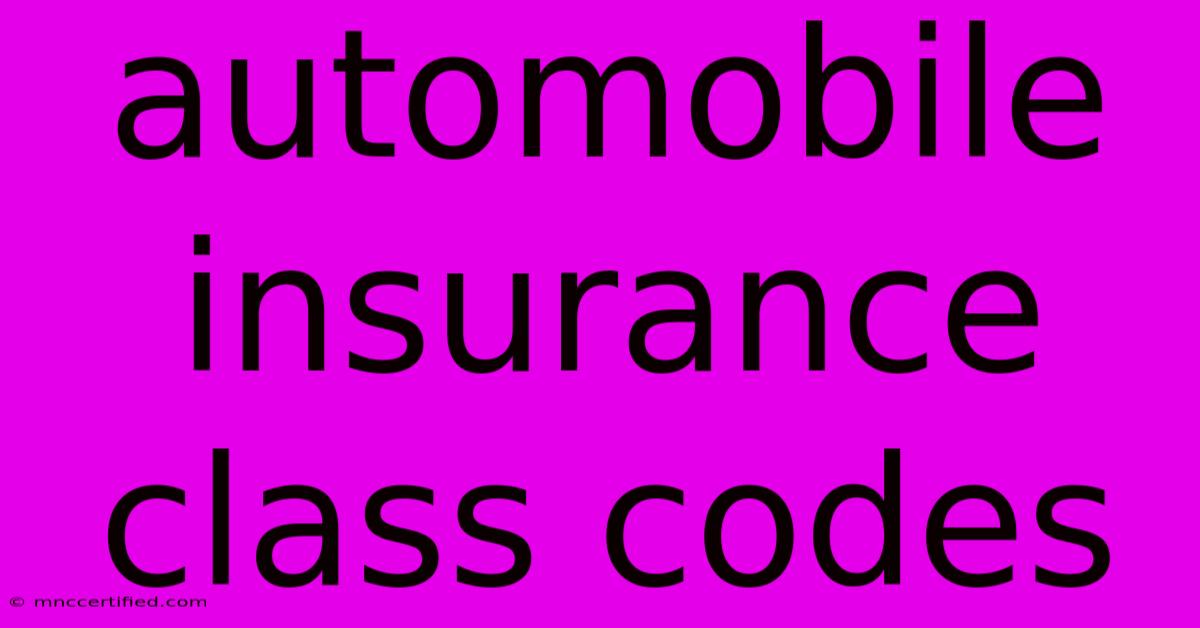Automobile Insurance Class Codes

Table of Contents
Decoding the Mystery: Understanding Automobile Insurance Class Codes
Choosing the right auto insurance can feel like navigating a minefield. One of the key, often overlooked, factors influencing your premium is your vehicle's insurance class code. This seemingly cryptic number actually holds significant weight in determining how much you'll pay. This article will demystify auto insurance class codes, explaining what they are, how they're determined, and why understanding them is crucial for securing the best possible rate.
What are Automobile Insurance Class Codes?
Auto insurance class codes are numerical designations assigned to vehicles based on various factors that assess the risk of insuring that specific type of car. Insurance companies use these codes to categorize vehicles into risk groups, allowing them to more accurately predict the likelihood of accidents, repairs, and claims. Essentially, they represent a complex risk assessment condensed into a simple number. Higher class codes generally indicate a higher risk profile and thus, higher premiums.
Factors Influencing Class Codes:
Several factors contribute to a vehicle's assigned class code. These include:
-
Vehicle Year, Make, and Model: Newer vehicles, luxury cars, and models with a history of high repair costs often fall into higher class codes. This is because newer cars generally have more complex technology, leading to more expensive repairs. Similarly, luxury vehicles often have higher parts and labor costs associated with repairs.
-
Vehicle Size and Weight: Larger, heavier vehicles are statistically more likely to cause significant damage in accidents, resulting in higher insurance class codes.
-
Safety Features: Cars equipped with advanced safety features, like anti-lock brakes (ABS), electronic stability control (ESC), and airbags, may receive lower class codes due to their reduced accident risk.
-
Engine Size and Power: High-performance vehicles with powerful engines are often categorized as higher risk due to their increased potential for accidents and more expensive repairs.
-
Theft Rate: Vehicles with a history of high theft rates will also likely have a higher class code.
How do Class Codes Affect Your Premium?
Your vehicle's insurance class code is a significant factor in determining your insurance premium. A higher class code translates to a higher premium, reflecting the increased risk the insurance company assumes. This isn't necessarily a reflection of your driving skills, but rather a prediction of the potential costs associated with insuring your specific vehicle.
Think of it like this: insuring a high-performance sports car is inherently riskier for the insurance company than insuring a compact sedan. The potential for accidents and the cost of repairs are significantly higher. This difference is reflected in the class codes and consequently, the premiums.
Finding Your Vehicle's Class Code:
Unfortunately, there's no single, publicly accessible database listing every vehicle's class code. The specific class code assigned to your vehicle can vary slightly depending on the insurance company. The best way to find out your vehicle's class code is to:
- Contact your insurance provider: They will have access to the specific code used in their system for your vehicle.
- Check your insurance policy: Your policy documents may list the class code.
Optimizing Your Insurance Costs:
While you can't directly control your vehicle's class code, you can take steps to lower your overall insurance premiums:
- Choose a safer vehicle: Consider safety ratings and features when buying a new or used car.
- Maintain a good driving record: A clean driving record significantly impacts your overall insurance rates, irrespective of your car's class code.
- Bundle your insurance: Combining auto insurance with other types of insurance, such as homeowners or renters insurance, can often result in discounts.
- Shop around for insurance: Compare quotes from multiple insurance providers to find the best rates for your specific situation.
Understanding your vehicle's insurance class code is a crucial step in making informed decisions about your auto insurance. By understanding the factors influencing these codes and actively managing your risk profile, you can work towards securing the most affordable and appropriate coverage for your needs. Remember, proactive research and comparison shopping can save you significant money in the long run.

Thank you for visiting our website wich cover about Automobile Insurance Class Codes. We hope the information provided has been useful to you. Feel free to contact us if you have any questions or need further assistance. See you next time and dont miss to bookmark.
Featured Posts
-
Janette Manraras Tv Jibe At Aljaz
Nov 21, 2024
-
Marinade Crypto Price Prediction
Nov 21, 2024
-
Armstrong Insurance Frostburg Md
Nov 21, 2024
-
Non Direct Mutual Life Insurance
Nov 21, 2024
-
No New Morrissey Album Free Speech Cited
Nov 21, 2024